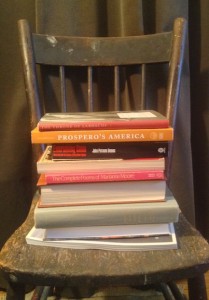
It’s not really a nightstand, it’s a vintage child’s chair, but it’s usually stacked with books. This week (from bottom to top):
Homeport Collections wholesale catalog. Why is this still here? Never mind.
Michael Wood. The Road to Delphi: The life and afterlife of oracles. What do we know and how do we know it? The ancients, I think, did not so much believe in oracles as they simply understood what they were good for: demonstrating the futility of foreknowledge (because foreknowledge — like any kind of knowledge, only more so — is always incomplete).
Donald D. Hall. Worlds of wonder, days of judgment: Popular religious belief in early New England. The puritans and pilgrims were of course nothing at all like the people we were taught about in grade school.
G.B. Shaw. Complete plays and prefaces, volume III. Rereading Arms and the Man, Caesar and Cleopatra, Man and Superman. All of his plays are funny, especially the serious ones. Nothing is so Terribly Important that it can’t do with a little mockery.
Marianne Moore. The complete poems. I had forgotten how really really good she is!
Kai T. Erikson. Wayward puritans: A study in the sociology of deviance. New England culture was very far from being monolithic. Outsiders thus serve to remind the insiders of who they are, and where no outsiders exist they must be created (much like Voltaire’s God).
John Putnam Demos. Entertaining Satan: Witchcraft and the culture of early New England. A statistical, sociological, and biographical account of the seventeenth-century Connecticut witch prosecutions.
Walter W. Woodward. Prospero’s America: John Winthrop, Jr., alchemy, and the creation of New England culture 1606–1676. Our emigrant ancestors were much stranger than we generally give them credit for. But then the past is always strange.
Gjertrud Schnackenberg. The throne of Labdacus. Rereading again. A book-length meditation on Oedipus, free will, guilt, redemption, art. I was reminded of it by Road to Delphi, above.